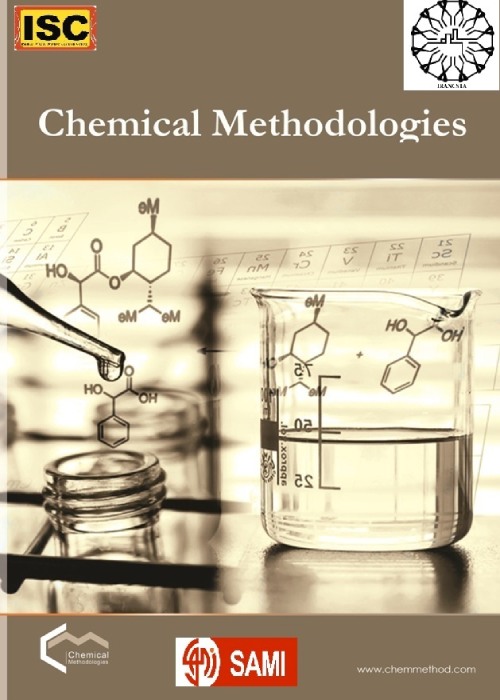فهرست مطالب
Chemical Methodologies
Volume:2 Issue: 2, May-Apr 2018
- تاریخ انتشار: 1397/01/12
- تعداد عناوین: 7
-
-
Pages 83-92In the present study, AgNO3 is employed as an effective catalyst for transesterification of β-keto esters with various alcohols under conventional and non-conventional conditions. The alcohols are easily converted into corresponding acetates in very good yields and less reaction times. However, a decrease in reaction times as well as moderate yields were observed when performed under non-conventional conditions such as Sonication and Microwave irradiation. Contrary to many other silver salts catalysts, AgNO3 has shown remarkable levels of activity and stability towards transesterification reaction. The tendency in reaction rates was found to be MWAS (3-6 min) <<< Sonication (30-45 min) <<< Conventional (8-12 hrs).Keywords: Transesterification, β-keto esters, Alcohols, AgNO3, conventional, non-conventional
-
Pages 93-102Different association parameters were evaluated for saturated paratoluic acid in the binary mixtures of ethanol-water at different temperatures by measuring the molal solubility and the mean activity coefficient. From the experimental solubility, pH, density data:- molar, Van der Waals, electrostriction, apparent molar volumes, dissociation constants, and association constants of paratoluic acid were estimated in order to estimate the contributions of solute-solvent interactions related to ion association. The saturated solution of paratoluic acid in the binary solvent mixtures of ethanol–water is perfectly non-ideal due to the mean activity coefficient of ions in the solution and partly due to the ion association phenomenon It was observed from the different volume values that all volumes for paratoluic acid were increased by increasing ethanol content in the mixed solvent due mainly to the higher solvation. It was concluded that the solute-solvent interaction increased by increasing ΔΔG and ΔGs due mainly to the increase in the association parameters in the corresponding solvents.Keywords: Paratoluic acid, Solubility, molar volumes, Thermodynamic, association parameters
-
Pages 103-113Nano sized metal oxide; ZnO and CdO have been synthesized by the thermal decomposition of two Schiff base complexes. Zinc and cadmium Schiff base complexes have been synthesized at reflux condition by the reaction between bidentate Schiff base ligand (E)-2-((4-methoxyphenylimino) methyl) phenol and nitrate salts of Zn or Cd in acetonitrile as a solvent. The nanoparticles of the title complexes were obtained using the ultrasonic irradiation method in acetonitrile as an anti-solvent of the Zn and Cd metal complexes, and also using spectroscopy and physicochemical methods including FT-IR, UV-Vis, elemental analysis, X-ray powder diffraction (XRD) and scanning electron spectroscopy (SEM). The .nanoparticles (NPs) of ZnO and CdO with the average size of 27 and 32 nm were prepared by thermal decomposition of the title nano metal complexes. The metal oxide was identified by XRD pattern and SEM images.Keywords: Schiff base complex, Nano zinc oxide, Nano Cadmium oxide, ultrasonic, Thermal decomposition
-
Pages 114-127The potentiodynamic polarization curves, quantum chemical calculation and molecular dynamics simulation methods are used to study the inhibition effects of Salen ligand regarding the corrosion of carbon steel (A105) in salty and acidic solutions of 3.5% NaCl and 1.0 M HCl respectively. The results show that the values of inhibition efficiency in 3.5% NaCl and 1.0 M HCl solutions are higher than 96% and 95% respectively at 25 oC. For both solutions, the adsorption of the inhibitor on steel surface corresponds the Langmuir adsorption isotherm, and the nature of adsorption is mainly chemical. All the results show that Salen is a good corrosion inhibitor for protection of steel in both Salty and acidic medium.Keywords: Acid corrosion, Electrochemical techniques, Density functional theory, Simulation analysis
-
Pages 128-140
During recent years, it has been shown that the thioTEPA molecule can play a very important role as an anticancer drug. The present research studies the structural and spectral properties and reactivity of the thioTEPA antitumor agent in confronting the sulfur-donor biomolecules (cysteine and methionine) and DNA purine bases (adenine and guanine). The study was done based on the quantum-mechanical computations. All studied compounds were optimized by B3LYP/6-31+G(d,p) basis set of theory. The IR computations showed no imaginary frequency for all compounds. So, the accuracy of our computational methods was proved. This study indicates that the adenine base has the best reaction with this antitumor drug among all biomolecules. So, the thioTEPA antitumor agent prefers to react with adenine base.
Keywords: Anticancer, Antitumor, Biomolecule, DFT, ThioTEPA -
Pages 141-165Background
Quetiapine fumarate is a dibenzothiazepine derivative and it is classified as a second-generation antipsychotic drug that has been established as an effective therapy for schizophrenia and bipolar disorder. These antipsychotics have a low incidence of extrapyramidal side effects and tardive dyskinesi as compared to older antipsychotics. The advantages of the therapeutic profile of quetiapine have led to increasing the use of the clinical practice encouraging the development of new pharmaceutical preparations.
ObjectiveThe goal of this work was to recognize the synthesis and analytical deference methods of quetiapine fumarate.
MethodsGenerally, A precise, specific, rapid and feasible reversed-phase high-performance liquid chromatographic (RP-HPLC), UV spectrophotometric and reversed phase ultra-performance liquid chromatography (RP-UPLC) methods for the determination of an antipsychotic drug quetiapine fumarate in pharmaceuticals, spiked human urine and plasma sample have been developed and collected in this review. The methods also find applications in clinical, biological and pharmacokinetic studies of quetiapine fumarate.
Keywords: Human plasma, Quetiapine fumarate, RP-HPLC, Spectrophotometry, Synthesis -
Pages 166-180In this study, previously estimated tannery effluent with high pollutant (Cr) load of 987 mg/L was detoxified using pyrolysed Moringaoleifera Pods(PMOP)and Shells (PMOS).A performance assessment of the gained and characterized adsorbents was based on equilibrium, rate and thermodynamic studies.An investigation was carried out on equilibrium studies using isotherm models (Langmuir, Freundlich, Dubinin-Radushkevich and Temkin isotherm models).The maximum adsorption capacity of PMOS is 277.3 mg/g. Sorption rate is best explained using the Pseudo-second order kinetic model with diffusion through the liquid film surrounding the solid sorbent. Comparison of performance with commercially available activated carbon shows no statistical significance at p< 0.05.Keywords: Diffusion, Isotherm, rate, Equilibrium, Adsorption, Moringaoleifera


